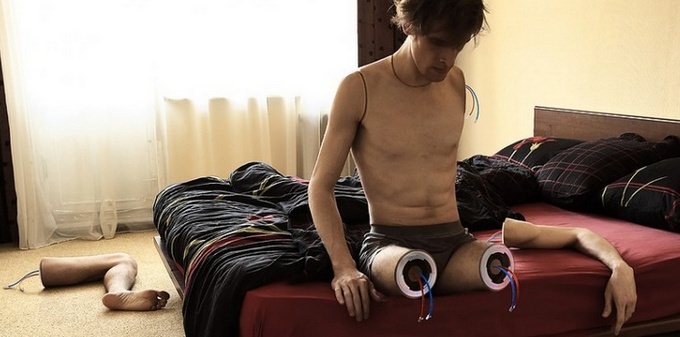The Five Types of Dreams (and How to Make Them Lucid)
My dream life is pretty intense.
And over the years I've categorized my dreams into five broad types.
Here's how to identify the nature of your dreams and how you can turn any of them into lucid dreams.
1. Daydreams

Studies reveal that the average person daydreams for a whopping 70-120 minutes of their waking day.
As with all types of dreams, you enter a kind of hypnotic trance and allow your unconscious thoughts to rise to the surface.
During daydreams, you are semi-awake. Clearly not asleep - but not fully checked-in with reality, either.
A daydream starts with a compelling thought, memory or fantasy, and your imagination runs away. The longer you daydream, the deeper you becomes immersed in your private fantasy land.
It's been suggested that people who daydream a lot find it easier to lucid dream.
That's because daydreaming is like practicing lucid dreaming while you're awake - observing imagery in your mind's eye and directing the course of your fantasy. In fact, visualization is one of the tenets of lucid dreaming practice.
Rehearsing The Future and Accepting The Past
In daydreams, the creative brain becomes dominant and you have less awareness of your physical reality.
Deeper worries or concerns can surface from the unconscious mind by acting themselves out in the daydream.
This serves to reinforce negative beliefs about the future or bad memories of traumatic events. So next time you find yourself fantasizing about a bad situation, actively turn it around and create a positive outcome for yourself.
Conversely, daydreaming is good for rehearsing positive outcomes too.
An athlete might visualize winning their next competition, a business leader might mentally rehearse an important speech.
I use daydreaming to visualize all sorts of goals actually happening to me. I really think this helps affect the outcome. Not in a spooky law-of-attraction kind of way but just hardwiring my brain to believe in myself and stay motivated.
Daydreams are awesome. They are psychologically healthy, helping you temporarily escape the demands of reality, release frustrations and plan for a better future!
How to Use Daydreaming to Stimulate Lucid Dreams
Daydreaming is part of the MILD method of lucid dream induction, as well as the WILD method. It's more often referred to as visualization, but it's the same thing.
I use daydreaming to set my next lucid dream goal.
Either during meditation or while I fall asleep, I daydream about a lucid dream seed situation - a location and any key characters. The more juice that goes into the daydream (intensity of the visualization and my desire for it to happen) the more likely I'll achieve it when lucid.
That way, the next time I become lucid, I'll automatically recall my plan and it'll come to life easily.
Without this preparation, I tend to get distracted by flying and poking around the dreamscape and its characters - which is of course heaps of fun but I have a lot of cool waking goals I want to fulfill as well.
2. Normal Dreams

These are your bog standard dreams where you have no idea you're dreaming until you wake up.
In a typical dream, you could be doing a rap duet with the Pope and think nothing of it. You accept your dream reality as it is.
Everybody has normal dreams every single night. These dreams arise mostly out of REM sleep and are essential to our survival.
In fact, we would eventually die without them. Assuming you get eight hours of shuteye, you will dream for about 100 minutes - with longer and more vivid dreams occurring at the end of your sleep.
Interpreting Your Dreams
Normal dreams offer insights from the unconscious mind.
These insights are based on your thoughts and experiences from the day before, sometimes memories from long ago, repressed fears and anxieties, and your strongest desires and urges.
It arrives in the form of conceptual imagery - the coded language of the unconscious mind - which is what makes your dreams seem so weird.
How to Use Normal Dreams to Stimulate Lucid Dreams
In the DILD method of becoming lucid, you'll use your normal dreams as a springboard to lucidity. All you need to do is recognize you're dreaming. Simple, no?
Spontaneous lucidity can happen to anyone, anytime they're dreaming.
But you can significantly boost your odds by getting into the mental habit of checking whether you're awake or dreaming. Reality checks are a fine example. But it's not a superficial "question / answer" game. It's a permanent mindset.
Once you realize you're dreaming, it awakens the conscious brain and the sensory system, so that your normal dream becomes a lucid dream.
It can look, feel, sound, smell and even taste as authentic as anything you experience in reality. Which is frikkin awesome. Even bizarre experiences - like shrinking yourself down to the size of an atom - feel astonishingly real.
3. Lucid Dreams

Lucid dreams are the best types of dreams, hands down.
They are richly immersive and you can guide them into infinite and beautiful worlds of your choosing. Lucid dreaming is the ultimate freedom.
What defines a lucid dream? It's any dream in which, while physically asleep, you also:
- know that you're dreaming; and/or
- can control the dream or direct your awareness
Sometimes I control lots of aspects of the dream - like the locations or characters or plot. But my dreaming mind still fills in a lot of details on its own.
Other times I let the dream guide me and show me whatever it wants. I'm still lucid because I can think clearly, acknowledge I'm dreaming and experience the dream in real-life intensity.
Learn how to lucid dream in ten minute lesson each night with our free course.
Most people use lucid dreams to fulfill personal desires. But once you look outside this feature, you'll realize lucid dreams offer brilliant insights into the unconscious mind.
4. False Awakenings

Ever watched Groundhog Day with Bill Murray?
False awakenings are a bit like that. You wake up as normal and plod into the bathroom, get dressed, eat breakfast, and maybe even get half way to work before you realize "oh my god, I'm still dreaming!
And then you wake up.
False awakenings are basically very vivid types of dreams.
Like any normal dream, you assume you're awake, and you certainly don't know you're dreaming (if you do, you're already lucid). It begins in your bedroom, or the last place you went to sleep - or even a different bed altogether.
You dream that you've woken up for real and somehow your brain mimics every detail of the room, exactly as it should be. Unless you question your reality (remember that reality check thing I mentioned earlier) you don't stand a chance...
It usually takes something quite obvious to shock you out of these types of dreams. Maybe you look in the bathroom mirror and see yourself 20 years from now. Or maybe you're driving down the road and realize there are no other cars on the road.
How to Use False Awakenings to Become Lucid
Some people report multiple false awakenings - one after the other in quick succession.
They get trapped in a seemingly never-ending cycle, tired of getting dressed for work for the seventh time that day.
If this happens to you often, it's a big fat sign for you to start doing reality checks. Especially when you wake up in the morning. The habit of morning checks will slide right into your false awakenings and BAM - a lucid dream.
Just be warned. If you become only semi-lucid it can get frustrating. I once had a false awakening that was so real, I couldn't accept I was dreaming, even after doing a successful reality check.
I wrestled with the question "am I dreaming?" for several minutes, banging on the glass of my bedroom window, trying to figure out if I could push my hand through. I just couldn't get myself to full lucidity. The environment was so perfectly real.
In the end, the dream revealed its true nature when I walked into the kitchen and found my partner cooking a roast dinner at 7am. I became lucid immediately and flew out the window.
False awakenings may be frustrating at times but aren't at all harmful.
They are also extremely vivid but not nightmarish in content. And if nothing else, they provide a fascinating talking point the next day.
5. Nightmares

In the Western world, nightmares are any normal dreams with a very scary twist.
In nightmares, you don't know you're dreaming. So the unconscious mind processes everything as if it were really happening. Some nightmares can be so vivid that the sensory system is triggered and you can feel certain types of pain. It can be very unnerving.
According to dream analysis, being chased in a nightmare represents our evolutionary fear of being hunted.
Children - who arguably feel more vulnerable than most adults - report this type of dream the most. Studies show that nightmares are usually caused by sickness, stress, trauma, and drugs or alcohol.
How to Turn Nightmares into Lucid Dreams
One brilliant way to start having lucid dreams is by being shocked into lucidity by a really bad nightmare.
Ever have that moment where you're being butchered by a madman and are screaming, "WAKE UP! WAKE UP!"
No? Just me then.
Technically, at that point, you're lucid. If you're shouting "wake up" then you know you're asleep.
But you need to get a grip in order to snap this into a lucid dream. Instead of trying to end the drama, be still for a moment and say, "I'm dreaming" instead. Just saying it out loud brings clarity to everything.
Your nightmare figure may disappear, begin to whimper like a child, or look embarrassed. At this point, instead of waking yourself up - go and seek out your ultimate desire. It's a much better use of your time.
(Even better than simply overcoming your nightmare figure is to engage in conversation with the source of your fear. In the calm light of lucidity you can have a meaningful exchange that helps explain the cause. Not only does this help you on a conscious level, it can also cancel out future nightmares - as now the issue has been heard.)
Final Thoughts
You came here wondering about different types of dreams…
And I bet you’ve learned a lot!
So maybe now it’s time to learn a bit more.
Everyone can learn to lucid dream . Our free course won’t cost you a dime.
And you might even unlock the hidden universe inside your own mind .
















